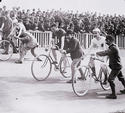 The early 19th century saw greater restriction on casual games on Glasgow Green and in the streets, accompanied by a reaction against activities such as cock-fighting and dog-baiting. Nonetheless, Glasgow got a new cockpit in 1835 with accommodation for 280 people. Swimming in the river seems to have been the most popular sport in the 1830s, but as the Clyde became more polluted enthusiasm dwindled. Springboards were finally removed in 1877. With the opening of a pool in Alexandra Park in 1877 and the opening of both private and public baths over the next two decades interest revived, notably with women bathers increasing in the early years of the twentieth century. Cricket became popular from the 1830s with the first Scottish championship involving the Glasgow Cricket Club in 1834. It was popular among young working-class men with over a dozen clubs playing on Glasgow Green by the 1840s. It was one of the first sports to have an agreed set of rules. Bowling was another popular activity with 200 clubs meeting in Glasgow in 1848 and agreeing rules drawn up by the solicitor, William Mitchell.
The early 19th century saw greater restriction on casual games on Glasgow Green and in the streets, accompanied by a reaction against activities such as cock-fighting and dog-baiting. Nonetheless, Glasgow got a new cockpit in 1835 with accommodation for 280 people. Swimming in the river seems to have been the most popular sport in the 1830s, but as the Clyde became more polluted enthusiasm dwindled. Springboards were finally removed in 1877. With the opening of a pool in Alexandra Park in 1877 and the opening of both private and public baths over the next two decades interest revived, notably with women bathers increasing in the early years of the twentieth century. Cricket became popular from the 1830s with the first Scottish championship involving the Glasgow Cricket Club in 1834. It was popular among young working-class men with over a dozen clubs playing on Glasgow Green by the 1840s. It was one of the first sports to have an agreed set of rules. Bowling was another popular activity with 200 clubs meeting in Glasgow in 1848 and agreeing rules drawn up by the solicitor, William Mitchell.
 It was from the 1860s that football began to gain in popularity with a football club set up in Queen's Park in 1867. Rangers started on the Green in 1872 before moving to Kinning Park. Within a decade football was becoming the most popular spectator sport and money began to be invested in grounds and in players. 20,000 spectators watched the first Hampden international in 1878, and 102,000 watched the match at the opening of a new Hampden Park in 1902. Crowds flocked to see the best players and this encouraged the development of professionalism. It was the beginning of a long battle between those who wanted to cling to amateurism and those who felt there was no real alternative to the professional route. Celtic F C, established in 1887, took the lead in forming the Scottish League in 1890 as a necessary step to professional competition. As a way of increasing income Rangers FC also had a cycle track in the 1880s for races. With the coming of the safety bicycle, cycling had become a popular participatory sport for men and women. Glasgow had at least thirty cycling clubs in 1896.
It was from the 1860s that football began to gain in popularity with a football club set up in Queen's Park in 1867. Rangers started on the Green in 1872 before moving to Kinning Park. Within a decade football was becoming the most popular spectator sport and money began to be invested in grounds and in players. 20,000 spectators watched the first Hampden international in 1878, and 102,000 watched the match at the opening of a new Hampden Park in 1902. Crowds flocked to see the best players and this encouraged the development of professionalism. It was the beginning of a long battle between those who wanted to cling to amateurism and those who felt there was no real alternative to the professional route. Celtic F C, established in 1887, took the lead in forming the Scottish League in 1890 as a necessary step to professional competition. As a way of increasing income Rangers FC also had a cycle track in the 1880s for races. With the coming of the safety bicycle, cycling had become a popular participatory sport for men and women. Glasgow had at least thirty cycling clubs in 1896.
 The division between predominantly amateur sports and predominantly professional ones largely became a class division. Cricket and lawn tennis, in the 1880s, became mainly middle class, while football and professional cycling were mainly working class in their audiences.
The division between predominantly amateur sports and predominantly professional ones largely became a class division. Cricket and lawn tennis, in the 1880s, became mainly middle class, while football and professional cycling were mainly working class in their audiences.